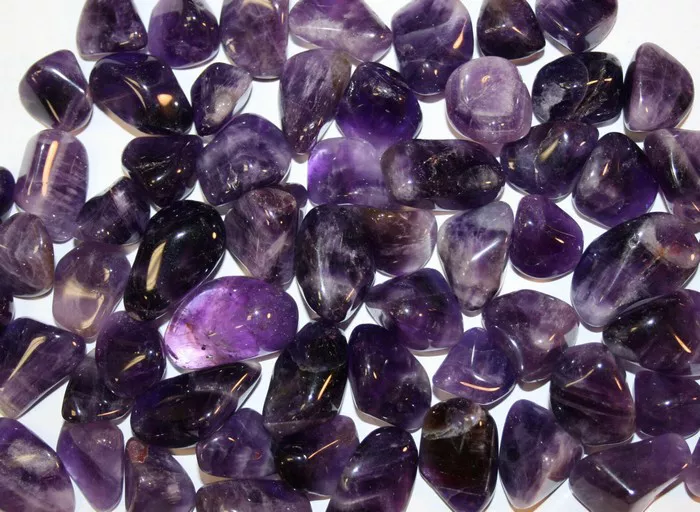Amethyst, a mesmerizing macrocrystalline quartz adorned with delicate iron inclusions, captivates the senses with its regal purple hues. Formed when quartz cooled below 420°C (788°F), this gemstone is celebrated for its natural variations, each telling a unique story of its journey through time and geology. Its allure and popularity stem not only from its stunning coloration but also from the myriad forms it takes in nature.This article will tell you about the types of amethyst, how to find it, and what its value is.
Types of Amethyst:
In the vast tapestry of geological formations, amethyst manifests in several captivating forms, each with its own distinct allure.
Geodes: These hollow rocks, adorned with crystalline wonders within, are among the most iconic forms of amethyst. The mystery of a geode lies in its unassuming exterior, which belies the breathtaking beauty concealed within.
Clusters: Smaller formations of crystals, clusters present a spectacle of natural artistry. Their intricate arrangements evoke a sense of wonder, as if nature herself sculpted these formations with meticulous care.
Points: Singular crystals boasting a terminated point, amethyst points stand as beacons of elegance. Their symmetrical perfection and ethereal coloration make them prized additions to any collection.
Grape Agate: Resembling clusters of luscious grapes, these spherical formations exude a whimsical charm. Their unique morphology sets them apart as treasures of the natural world.
Among these forms, amethyst geodes stand out for their sheer size and prevalence. Found in diverse environments ranging from gravel beds to remote outcrops, these geological marvels never fail to enchant with their grandeur.
Where to Find Amethyst:
Amethyst enthusiasts embark on a quest spanning continents in search of these coveted gemstones, with each locale offering its own distinct treasures.
United States:
Amethyst enthusiasts in the United States are in luck, as there are several states known for their abundant amethyst deposits. Among these states are Pennsylvania, New Hampshire, Virginia, North Carolina, and South Carolina. These regions boast diverse environments where amethyst can be found, including gravels, creeks, mine dumps, quarries, lake shores, pegmatites, gulches, outcrops, and road cuts.
Pennsylvania, for instance, is home to the famous Ringing Rocks Park, where visitors can hunt for amethyst amidst the ringing boulders. In North Carolina, the Hiddenite area is renowned for its rich gemstone deposits, including amethyst. South Carolina’s abundance of pegmatite mines provides ample opportunities for amethyst prospecting.
International Locations:
Beyond the borders of the United States, amethyst enthusiasts can explore a wealth of international locations renowned for their high-quality deposits.
Namibia, located in southwestern Africa, is celebrated for its deep purple amethyst crystals, often found in association with quartz. Siberia, the vast Russian region known for its extreme cold, also harbors notable amethyst deposits, particularly in the Ural Mountains.
Sri Lanka, situated off the southern coast of India, has a long history of gemstone mining, including the extraction of fine amethyst specimens. The Far East, encompassing countries such as China, Japan, and South Korea, offers diverse geological formations where amethyst can be discovered.
Brazil stands out as one of the world’s largest producers of amethyst, with vast deposits located in the southern state of Rio Grande do Sul. Uruguay is renowned for its distinctive amethyst geodes, prized for their deep color and crystal formations. Australia, particularly Queensland and New South Wales, boasts significant amethyst deposits as well.
Other Countries:
Several other countries around the globe are known for their amethyst deposits, albeit to varying extents. Russia, beyond Siberia, hosts amethyst mines in regions such as the Middle Urals. Canada, with its expansive territory, offers amethyst hunting opportunities in provinces like Ontario and Quebec.
Germany, historically associated with gemstone cutting and jewelry craftsmanship, has small-scale amethyst deposits scattered across the country. Afghanistan, Italy, Austria, Pakistan, and Hungary also boast localized sources of amethyst, contributing to the global supply chain of this beloved gemstone.
Value of Amethyst:
Beyond its intrinsic beauty, amethyst holds practical value as well, finding its place in the world of jewelry and adornment.
Jewelry: Crafted into exquisite pieces, amethyst adorns necklaces, rings, and earrings with an air of elegance. Its versatility allows it to complement a range of styles, from classic to contemporary.
Faceted Amethyst: Properly faceted specimens with deep saturation and high clarity command admiration and respect. Their brilliance and luster elevate them to the realm of coveted treasures.
Color Zoning: Within the kaleidoscopic world of amethyst, the concept of color zoning adds another layer of intrigue. This phenomenon, characterized by variations in hue and intensity within a single crystal, lends each specimen a unique personality.
Pricing Confusion: Despite its widespread popularity, confusion often surrounds the pricing of amethyst. Factors such as size, clarity, and color intensity contribute to the wide range of prices observed in the market. As such, determining the true value of an amethyst specimen requires careful consideration and expertise.
In conclusion, the allure of amethyst knows no bounds, captivating the hearts and minds of collectors and enthusiasts around the world. Whether nestled within the rocky embrace of a geode or sparkling in a jewelry setting, amethyst remains a timeless symbol of beauty and wonder, inviting all who encounter it to marvel at nature’s boundless creativity.


